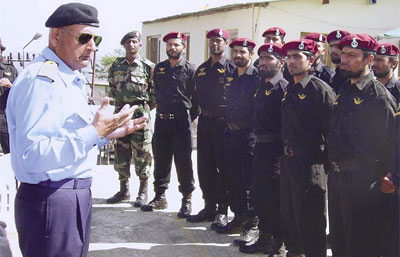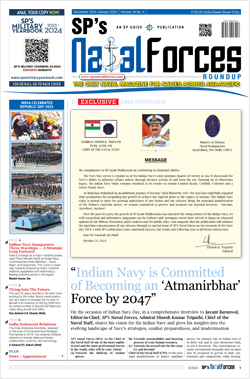INDIAN ARMED FORCES CHIEFS ON OUR RELENTLESS AND FOCUSED PUBLISHING EFFORTS

The insightful articles, inspiring narrations and analytical perspectives presented by the Editorial Team, establish an alluring connect with the reader. My compliments and best wishes to SP Guide Publications.

"Over the past 60 years, the growth of SP Guide Publications has mirrored the rising stature of Indian Navy. Its well-researched and informative magazines on Defence and Aerospace sector have served to shape an educated opinion of our military personnel, policy makers and the public alike. I wish SP's Publication team continued success, fair winds and following seas in all future endeavour!"

Since, its inception in 1964, SP Guide Publications has consistently demonstrated commitment to high-quality journalism in the aerospace and defence sectors, earning a well-deserved reputation as Asia's largest media house in this domain. I wish SP Guide Publications continued success in its pursuit of excellence.
- MoD initiates comprehensive review of Defence Acquisition Procedure 2020, pushes for defence reforms
- G7: The Swansong
- Kalinga Connect: South Asia to Polynesia
- Advanced MRSAM for India for a greater firepower
- Must Credit DRDO for Operation Sindoor, now what is next for defence R&D?
- Operation Sindoor | Day 2 DGMOs Briefing
- Operation Sindoor: Resolute yet Restrained
Coastal Management
Review & Road Ahead

During a recent high-level review, Defence Minister A.K. Antony directed the IN and the coast guard to plug deficiencies in the working of coastal security network
India has 15,106.7 km of land border running through 92 dis-tricts in 17 states and a coast-line of 7,516.6 km touching 13 states and Union Territories. India’s total number of islands is 1,197 which accounts for a stretch of 2,094 km additional border or coastline. Ministry of Home Affairs, Department of Border Management has a Border Area Development Programme started dur-ing the Seventh Plan with the twin objectives of balanced development of sensitive border areas in the western region through adequate provision of infrastructure facilities and promo-tion of a sense of security among the local population. The programme was revamped in the Eight Plan and extended to states which have an international border with Bangladesh.
The land borders have been continu-ously under focus due to the hostile nature of certain neighbouring countries and disputed borders. However, the same is not true of the coastal areas. There are some disputed areas in the Exclusive Economic Zone (EEZ) but apart from this, there are routine problems of smuggling and illegal fishing. Division of responsibility among effected agencies is such that the Indian Coast Guard functions between 12 and 200 nautical miles, which is the EEZ, while marine police keep watch inside the 12 nautical miles of territorial waters and the navy beyond 200 nautical miles of blue water. There is continuous movement of all types of ves-sels for trade, fishing, military, policing, sports, and so on. On each Indian coast there are reportedly 1,50,000 small fishing boats with no modern navigation means or communications. Management of such a coastline is a formida-ble assignment and when super imposed with the template of terrorism, the task becomes all the more complex and challenging.
Post Kargil
The events of 26/11 resulted in deep intro-spection by the Government of India resulting in the establishment of committees to recom-mend the future course of action in order to pre-empt a recurrence. Fact is, such efforts and intentions have been voiced after every terror strike, be it on the Indian Parliament or in the Kaluchak Cantonment, but still terror-ists have struck with impudence and at will. Immediately after Kargil, the Group of Ministers (GoM) working under L.K. Advani made its recommendations in the form of a public docu-ment titled “Reforming the National Security System” in February 2001. Its recommenda-tions on coastal security, even after eight years, are relevant. Briefly, these are:
• While the Jammu and Kashmir border is still active; Rajasthan, Gujarat, Maharashtra and the west coast of the country are also being used for the purpose of smuggling arms. The smugglers have acquired high-powered speed boats.
• The concept of border security has under-gone a sea change with the growing vulner-ability of the coastline and also of the airspace. In response to strengthening of security... along a sensitive land border, the transgressor is already on the lookout for soft gaps...along the coast, and if need be, from the air.
• Little has been done over the years to understand or take action to create the infra-structure for the protection of India’s vast coastal areas.
• The GoM felt that it was desirable to set up a Specialized Marine Police in all coastal states and island territories.
Evidently, the GoM’s report was not imple-mented seriously otherwise 26/11 could per-haps have been averted.
Post 26/11
The same exercise was repeated post 26/11 and a comprehensive package of measures were announced by Defence Minister A.K. Anthony after its approval by the Cabinet Committee on Security. Salient features were:
• The Indian Navy (IN) has been made responsible for overall maritime security, which includes both coastal and offshore security. The Indian Coast Guard, State Marine Police and other central and state agencies are to assist the IN in terms of coastal defence.
• Four Joint Operation Centres (JOCs) are to be established at Mumbai, Visakhapatnam, Kochi and Port Blair and placed under the jurisdiction of the respective C-in-C. The JOCs are to be manned and operated jointly by the IN and the coast guard, with requisite inputs from diverse agencies.
• The respective Naval Cs-in-C will hold additional responsibility as Cs-in-C, Coastal Defence.
• A ‘National Command, Control, Communication and Intelligence’ network would be established for real-time Maritime Domain Awareness linking the operations rooms of the IN and the coast guard, both at the field and the apex levels.
• The IN will control all navy-and-coast-guard joint operations.
• Assets, such as ships, boats, helicopters, aircraft, and so on, as also the manpower of the coast guard, will be increased.
• A specialised force, called “Sagar Prahari Bal”, comprising 1,000 personnel and tasked with protecting naval assets and bases on both the east and the west coasts, as well as the island territories, is to be created.
• This force will procure 80 Fast Interception Crafts for sea front patrolling.
• A new Coast Guard Regional HQ will be set up in Gujarat, under the newly created post of COMCG (North-West), to look after surveil-lance off the coast of Gujarat, Daman and Diu.
• ‘Vessel and Air Traffic Management Systems’ will be installed by the Ministry of Petroleum to cover all offshore development areas, as has been done in the western offshore region.
• The Indian Coast Guard has been addition-ally designated as the authority responsible for coastal security within Territorial Waters, includ-ing areas to be patrolled by the coastal police.
• The Director General Coast Guard is des-ignated as ‘Commander Coastal Command’ and made responsible for overall coordination between central and state agencies.
• The setting up of nine additional Coast Guard Stations to integrate into the ‘hub-and-spoke concept’ with coastal police stations along with manpower.
• The proposal for setting up of Static Coastal Radar Chain and a comprehensive network chain of ‘Automatic Identification System’ sta-tions along the entire coast as well as island territories has been approved.





